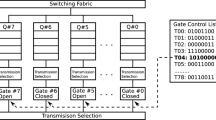Abstract
We develop analyticalscheduling models for both the original IEEE 802.5 token ring protocol and a recent extension to the original protocol that allows early token release (ETR). A scheduling model is an abstraction that supports reasoning about the timing correctness of a given set of real-time messages scheduled on the network. Scheduling analysis of the original IEEE 802.5 token ring protocol has previously been discussed in Strosnider and Marchok (1989) and Pleinevaux (1992) in the context of improving responsiveness of soft deadline aperiodic messages. In contrast, this paper develops schedulability conditions for arbitrary periodic message sets. The main contributions of this work are: Scheduling models for both the original protocol and ETR protocol; comparison for maximum achievable utilizations for the two protocols; comparison between the original protocol and ETR from a schedulability viewpoint. We also demonstrate the utility of our scheduling models to select network operating parameters such as maximum packet size, and to quantify effects of parameters such as the number of stations, and network size on schedulability.
Similar content being viewed by others
References
G. Agrawal, B. Chen, W. Zhao, and S. Davari. Guaranteeing synchronous message deadlines in high speed token ring networks with timed token protocol. InProceedings of IEEE International Conference on Distributed Computing Systems, 1992.
K. Arvind, K. Ramamritham, and J. Stankovic. A local area network architecture for communication in distributed real-time systems.Journal of Real-Time Systems, 3:115–147, 1991.
IEEE.IEEE Std 802.5, Token Ring Access Method and Physical Layer Specification, 1992-06-12, 1.0 edition, 1992.
H. Kopetz and W. Ochsenreiter. Clock synchronization in distributed real-time systems.IEEE Transactions on Computers, C-36(8):933–940, August 1987.
J. Kurose, M. Schwartz, and Y. Yemini. Multiple-access protocols and time-constrained communication.Computing Surveys, 16(1):43–70, March 1984.
C. Liu and J. Layland. Scheduling algorithms for multiprogramming in a hard real-time environment.Journal of the ACM, 30(1):46–61, January 1973.
J. Lehoczky and L. Sha. Performance of real-time bus scheduling algorithms.ACM Performance Evaluation Review, Special Issue, 14(1), May 1986.
Y. Lee and L. Shen. Real-time communication in multiple token ring networks.11th IEEE Real-Time Systems Symposium, pages 146–153, December 1990.
J. Lehoczky, L. Sha, and Y. Ding. The rate monotonic scheduling algorithm: Exact characterization and average case behavior.10th IEEE Real Time Systems symposium, 1989.
C. Lim, L. Yao, and W. Zhao. A comparative study of three token ring protocols for real-time communications.11th IEEE International Conference on Distributed Computing Systems, pages 308–317, May 1991.
P. Pleinevaux. An improved hard real-time scheduling for the IEEE 802.5.Journal of Real-Time Systems, 4(2):99–112, June 1992.
K. Ramamritham. Channel characteristics in local area hard real-time systems. InComputer Networks and ISDN Systems, pages 3–13, 1987.
S. Sathaye.Scheduling Real-Time Traffic in Packet-Switched Networks. PhD thesis, Carnegie Mellon University, Pittsburgh, PA, June 1993.
S. Sathaye, D. Katcher, and J. Strosnider. Fixed priority scheduling with limited priority levels. Technical Report CMU-CDS-92-7, Carnegie Mellon University, August 1992.
J. Strosnider and T. Marchok. Responsive, deterministic IEEE 802.5 token ring scheduling.Journal of Real-Time Systems, 1:133–158, 1989.
L. Sha, R. Rajkumar, and J. Lehoczky. Priority inheritance protocols: An approach to real-time synchronization.IEEE Transactions on Computers, 39(9):1175–1185, September 1990.
L. Sha, R. Rajkumar, and J. Lehoczky. Real-time computing using Futurebus+.IEEE Micro, June 1991.
L. Sha and S. Sathaye. Distributed real-time system design using generalized rate monotonic theory.Second International Conference on Automation, Robotics and Computer Vision, September 1992.
L. Sha, S. Sathaye, and J.K. Strosnider. Scheduling real-time communication on dual link networks.13th IEEE Real-Time Systems Symposium, pages 188–197, December 1992.
J. Strosnider.Highly Responsive Real-time Token Rings. PhD thesis, Carnegie Mellon University, Pittsburgh, PA, August 1988.
Author information
Authors and Affiliations
Rights and permissions
About this article
Cite this article
Sathaye, S.S., Strosnider, J.K. Conventional and early token release scheduling models for the IEEE 802.5 token ring. Real-Time Syst 7, 5–32 (1994). https://doi.org/10.1007/BF01088620
Issue Date:
DOI: https://doi.org/10.1007/BF01088620




